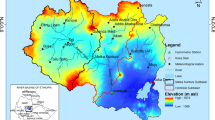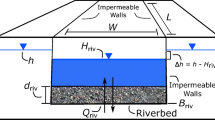Abstract
Enxoé is a small temporary river with a flushy regime, which flash floods carry significant loads to the reservoir. As a result, the reservoir, which supplies 25,000 inhabitants, exhibits a high trophic state and cyanobacteria blooms since its construction in 1998, with water abstractions requiring extensive treatment. This study aimed to understand the contribution of flash floods to the Enxoé’s reservoir high trophic state using a modeling approach. This was the first time the river was monitored and that a modeling study was carried out. The MOHID-Land model was implemented to assess the water path in the catchment, and was integrated with field data to compute river loads. Results confirmed the importance of flash events. During flash floods, water properties were determined by soil surface and river bottom wash out, and depended mostly on the flush sequence and intensity. Model simulations showed that soil surface permeability reduction was an important factor regulating surface runoff while soil moisture was low. The first flood after the dry period contributed to 2% of the yearly discharge, 3% of yearly N load, and 7% of the yearly P loads. Winter floods contribution differed, producing 10% of both yearly discharge and loads. However, concentration of particulate matter and organic compounds in the first flood were one order of magnitude higher than in winter floods. This was due to river bottom resuspension and erosion of riparian areas, representative dynamics of a flushy regime. During subsequent winter floods, nutrient concentrations tended to remain constant as the watershed surface and respective soils were washed. Further work should link a watershed model to a reservoir model to depict the flood impact in the reservoir, and test management strategies to reduce the reservoir trophic state.

Source Corine 2000







Similar content being viewed by others
References
Allen RG, Pereira LS, Raes D, Smith M (1998) Crop evapotranspiration—guidelines for computing crop water requirements. Irrig drain paper 56. FAO, Rome
Al-Qurashi A, McIntyre M, Wheater H, Unkrich C (2008) Application of the Kineros2 rainfall–runoff model to an arid catchment in Oman. J Hydrol 355:91–105
Alvarez-Cobelas M, Sánchez-Andrés R, Sánchez-Carrillo S, Angeler DG (2010) Nutrient contents and export from streams in semiarid catchments of central Spain. J Arid Environ 74(8):933–945
ASCE (1996) Hydrology handbook. American Society of Civil Engineers, Task Committee on Hydrology Handbook, II Series. GB 661.2.H93.1996.96-41049
Assouline S (2004) Rainfall-induced soil surface sealing: a critical review of observations, conceptual models, and solutions. Vadose Zone J 3:570–591
Assouline S, Ben-Hur M (2006) Effects of rainfall intensity and slope gradient on the dynamics of interrill erosion during soil surface sealing. Catena 66:211–220
Bernard-Jannin L, Brito D, Sun X, Jauch E, Neves R, Sauvage S, Sánchez-Pérez JM (2016) Spatially distributed modelling of surface water-groundwater exchanges during overbank flood events—a case study at the Garonne River. Adv Water Res 94:146–159
Bertrand-Krajewski J-L, Chebbo G, Saget A (1998) Distribution of pollutant mass vs volume in stormwater discharges and the first flush phenomenon. Water Res 32(8):2341–2356
Bicknell BR, Imhoff JC, Kittle JL, Donigian AS, Johanson RC (1993) Hydrological simulation program—FORTRAN (HSPF): users manual for release 10. EPA-600/R-93/174, U.S. EPA, Athens, GA, 30605
Boughton W, Droop O (2003) Continuous simulation for design flood estimation—a review. Environ Model Soft 18:309–318
Brito D, Neves R, Branco MA, Prazeres Â, Rodrigues S, Gonçalves MC, Ramos TB (2017) Assessing water and nutrient long-term dynamics and loads to an eutrophic reservoir in the Enxoé temporary river basin, southeast Portugal. Appl Water Sci (under review)
Brunner GW (2010) HEC-RAS river analysis system user’s manual. ver. 4.1
Chahinian N, Moussa R, Andrieux P, Voltz M (2005) Comparison of infiltration models to simulate flood events at the field scale. J Hydrol 306:191–214
Chen N, Wu J, Hong H (2012) Effect of storm events on riverine nitrogen dynamics in a subtropical watershed, southeastern China. Sci Total Environ 431:357–365
Dechmi F, Burguete J, Skhiri A (2012) SWAT application in intensive irrigation systems: model modification, calibration and validation. J Hydrol 470–471:227–238
Donnelly-Makowecki LM, Moore RD (1999) Hierarchical testing of three rainfall-runoff models in small forested catchments. J Hydrol 219:136–152
FAO (2006) World reference base for soil resources. A framework for international classification, correlation and communication. World Soil Resource Report 103. Food and Agriculture Organization of the United Nations, Rome
Feddes RA, Kowalik PJ, Zaradny H (1978) Simulation of field water use and crop yield. Simulation Monographs Pudoc, Wageningen
Fohrer N, Eckhardt K, Haverkamp S, Frede HG (2001) Applying the SWAT model as a decision support tool for land use concepts in peripheral regions in Germany. Sustaining Global Farm. In: Papers from the 10th international soil conservation organization meeting, pp 994–999
Geza M, McCray JE (2008) Effects of soil data resolution on SWAT model stream flow and water quality predictions. J Environ Manag 88:393–406
Green CH, van Griensven A (2008) Autocalibration in hydrologic modeling: using SWAT2005 in small-scale watersheds. Environ Model Soft 23:422–434
Havnø K, Madsen MN, Dørge J (1995) MIKE 11—A generalized river modelling package. In: Singh VP (ed) Computer models of watershed hydrology. Water Resources Publications, Colorado, pp 809–846
House WA, Warwick MS (1998) Hysteresis of the solute concentration/discharge relationship in rivers during storms. Water Res 32:2279–2290
Hsu MH, Chen SH, Chang TJ (2000) Inundation simulation for urban drainage basin with storm sewer system. J Hydrol 234:21–37
INAG (2004) Plano de Ordenamento da Albufeira do Enxoé, estudos de caracterização e pré-proposta de ordenamento. Instituto Nacional da Água, Lisboa
INE (2001) Recenseamento Geral Agrícola. Instituto Nacional de Estatística, Lisboa
James AL, Roulet NT (2009) Antecedent moisture conditions and catchment morphology as controls on spatial patterns of runoff generation in small forest catchments. J Hydrol 377:351–366
Li YX, Tullberg JN, Freebairn DM, Li HW (2009) Functional relationships between soil water infiltration and wheeling and rainfall energy. Soil Tillage Res 104:156–163
Li H, Sivapalan M, Tian F (2012) Comparative diagnostic analysis of runoff generation processes in Oklahoma DMIP2 basins: the Blue River and the Illinois River. J Hydrol 418–419:90–109
Lillebø AI, Morais M, Guilherme P, Fonseca R, Serafim A, Neves R (2007) Nutrient dynamics in Mediterranean temporary streams: a case study in Pardiela catchment (Degebe River, Portugal). Limnologica 37(4):337–348
Michaud J, Sorooshian S (1994) Comparison of simple versus complex distributed runoff models on a midsized semiarid watershed. Water Resour Res 30:593–605
Moriasi DN, Arnold JG, Van Liew MW, Bingner RL, Harmel RD, Veith TL (2007) Model evaluation guidelines for systematic quantification of accuracy in watershed simulations. Trans ASABE 50(3):885–900
Nash JE, Sutcliffe JV (1970) River flow forecasting through conceptual models: part 1. A discussion of principles. J Hydrol 10(3):282–290
Neitsch SL, Arnold JG, Kiniry JR, Srinivasan R, Williams JR (2002) Soil and water assessment tool. User´s manual. Version 2005. GSWRL Report 02-02, BRC Report 2-06, Temple, Texas, USA
Neves R (2013) The MOHID concept. In: Mateus M, Neves R (eds) Ocean modelling for coastal management e case studies with MOHID. IST Press, Lisbon, pp 1–11
Obermann M, Froebrich J, Perrin J-L, Tournoud M-J (2007) Impact of significant floods on the annual load in an agricultural catchment in the Mediterranean. J Hydrol 334:99–108
Obermann M, Rosenwinkel KH, Tournoud MG (2009) Investigation of first flushes in a medium-sized Mediterranean catchment. J Hydrol 373:405–415
Oeurng C, Sauvage S, Sánchez-Pérez JM (2010) Temporal variability of nitrate transport through hydrological response during flood events within a large agricultural catchment in south–west France. Sci Total Environ 409:140–149
Panagopoulos Y, Makropoulos C, Mimikou M (2011) Reducing surface water pollution through the assessment of the cost-effectiveness of BMPs at different spatial scales. J Environ Manag 92:2823–2835
Panday S, Huyakorn P (2004) A fully-coupled physically-based spatially distributed model for evaluating surface/subsurface flow. Adv Water Resour 27:361–382
Panini T, Torri D, Pellegrini S, Pagliai M, Salvador-Sanchis MP (1997) A theoretical approach to soil porosity and sealing development using simulated rainstorms. CATENA 31:199–218
Ramos MC, Nacci S, Pla I (2000) Soil sealing and its influence on erosion rates for some soils in the Mediterranean area. Soil Sci 165:398–403
Ramos TB, Gonçalves MC, Branco MA, Brito D, Rodrigues S, Sánchez-Pérez JM, Suavage S, Prazeres A, Martins JC, Fernandes ML, Pires FP (2015) Sediment and nutrient dynamics during storm events in the Enxoé temporary river, southern Portugal. CATENA 127:177–190
Ritchie JT (1972) Model for predicting evaporation from a row crop with incomplete cover. Water Resour Res 8(5):1204–1213
Rozalis S, Morin E, Yair Y, Price C (2010) Flash flood prediction using an uncalibrated hydrological model and radar rainfall data in a Mediterranean watershed under changing hydrological conditions. J Hydrol 394:245–255
Saxton KE, Rawls WJ, Romberger JS, Papendick RI (1986) Estimating generalized soil–water characteristics from texture. Soil Sci Soc Am J 50(4):1031–1036
Singer MJ, Le Bissonnais Y (1998) Importance of surface sealing in the erosion of some soils from a mediterranean climate. Geomorphology 24(1998):79–85
Trancoso AR, Braunschweig F, Chambel-Leitão P, Obermann M, Neves R (2009) An advanced modeling tool for simulating complex river systems. Sci Total Environ 407:3004–3016
van Genuchten MTh (1980) A closed form equation for predicting the hydraulic conductivity of unsaturated soils. Soil Sci Soc Am J 44:892–898
Wanielista MP, Yousef YA (1993) Stormwater management. Wiley, Hoboken
Woolhiser DA, Smith RE, Goodrich DC (1990) KINEROS, a kinematic runoff and erosion model: documentation and user manual. USDA research service, ARS-77, p 130
Acknowledgements
The present work was supported within the framework of the EU Interreg SUDOE IVB program (SOE1/P2/F146 AguaFlash project), the Mirage Project (EU-FP7), and the EUTROPHOS Project (PTDC/AGR-AAM/098100/2008) of the Fundação para a Ciência e a Tecnologia (FCT). MARETEC acknowledges the ERDF Funds of the Competitiveness Factors Operational Programme—COMPETE, and National Funds from the FCT (Project UID/EEA/50009/2013). T. B. Ramos was supported by the FCT Grant SFRH/BPD/110655/2015.
Author information
Authors and Affiliations
Corresponding author
Rights and permissions
About this article
Cite this article
Brito, D., Neves, R., Branco, M.A. et al. Modeling flood dynamics in a temporary river draining to an eutrophic reservoir in southeast Portugal. Environ Earth Sci 76, 377 (2017). https://doi.org/10.1007/s12665-017-6713-7
Received:
Accepted:
Published:
DOI: https://doi.org/10.1007/s12665-017-6713-7




